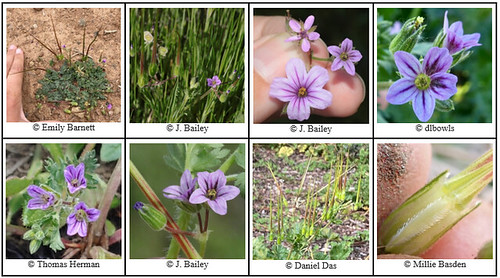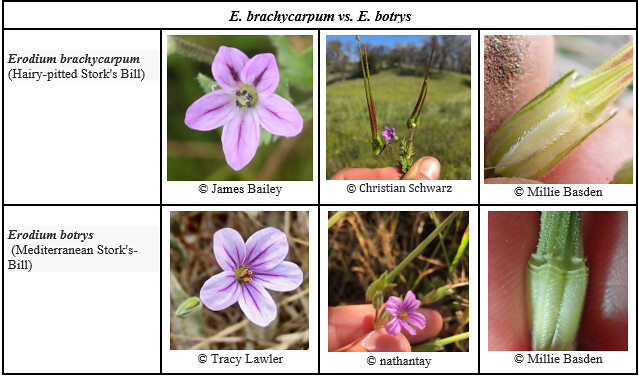How to identify Erodium brachycarpum (Hairy-pitted Stork's Bill)
This project collects observations of Erodium brachycarpum (Hairy-pitted Stork's Bill) in California for the purpose of facilitating identification and preventing misidentification of this species in iNaturalist.
Photo tips:
- It’s important to get a picture of the entire plant.
- It's also helpful to get close-up pictures of the face of the flowers, sepals, leaves, and fruits, if present.
- For this species, it’s important to get a close-up photo of the fruit pit.
- If the flower is smaller than your thumbnail, it’s helpful to get a measurement to differentiate from E. botrys.
- If there are multiple plants in the picture, it’s helpful to crop your photo to focus on the plant of interest.
How to identify Erodium brachycarpum:
- Jepson and other references don't discuss flowers well since they tend to completely disintegrate moments after the plant is collected. But if you have a live plant, the flower is your go-to for ID.
- E. brachycarpum is very small. The following observation shows the entire plant can fit in the palm of your hand: https://www.inaturalist.org/observations/41530948
- At least one petal group has only one dark purple streak on the petals.
- E. brachycarpum has small bisymmetrical flowers (with two slightly larger petals above three slightly smaller ones). This is because the flowers are composed of 5 petals, with 2 of them differing from the other 3 in shape and pattern (hence, "2 petal groups"). It shows well in the banner photo, and most E. brachycarpum exhibit this feature.
- Sepals do not have the red stripe that is seen in E. botrys.
- E. brachycarpum has rounded pits at the base of the fruits, subtended by 1–2 hairy ridges.
How to differentiate E. brachycarpum from E. botrys:
See the following comparison of E. botrys with E. brachycarpum by silversea_starsong:
** https://www.inaturalist.org/observations/2827189
** https://www.inaturalist.org/observations/25132485- E. brachycarpum has bisymmetrical flowers (with two slightly larger petals above three slightly smaller ones); E. botrys has symmetrical flowers.
- E. brachycarpum flowers are about 1/3 the size of E. botrys flowers or roughly the same size as E. cicutarium flowers.
- E. brachycarpum petals have a single dark stripe, at least in one petal group; E. botrys has broader blunt-tipped petals with multiple dark stripes.
- One of the five E. botrys sepals always has a dark red stripe on its margins; E. brachycarpum sepals don’t have the red stripe.
- The pits are the another way to differentiate these two species. Here's the illustration showing the difference: https://ucjeps.berkeley.edu/images/illustrations/fp-825-2.png
- The glandularity of stem hairs is inconsistent; @silversea_starsong has seen glandular and non-glandular stems on both species. Granted, it also depends on which part of the stem you compare, and the growing conditions.
These observations show the relative sizes of E. botrys, E. citutarium, and E. brachycarpum:
** https://www.inaturalist.org/observations/21878840
** https://www.inaturalist.org/observations/40711875These photos show E. brachycarpum flowers compared to E. cicutarium:
** https://www.inaturalist.org/observations/10394261
** https://www.inaturalist.org/observations/71626111- See the discussion for the following observation: https://www.inaturalist.org/observations/40934567
See these projects for many examples of each species:
** https://www.inaturalist.org/projects/erodium-brachycarpum-hairy-pitted-stork-s-bill
** https://www.inaturalist.org/projects/erodium-botrys-mediterranean-stork-s-bill
References:
- Calflora: https://www.calflora.org/app/taxon?crn=3447
Jepson eFlora:
** https://ucjeps.berkeley.edu/eflora/eflora_display.php?tid=25038
** https://ucjeps.berkeley.edu/images/illustrations/fp-825-2.png- EOL: https://eol.org/pages/467959/articles
- Monterey Wildflowers: https://montereywildflowers.com/geraniaceae-erodium/
- Yosemite Hikes: https://www.yosemitehikes.com/wildflowers/filaree/filaree.htm
iNaturalist:
** How to identify Erodium brachycarpum (Hairy-pitted Stork's-Bill)
** https://www.inaturalist.org/taxa/58171-Erodium-brachycarpum
** Parent Project: https://www.inaturalist.org/projects/erodium-genus-stork-s-bills-california/
** https://www.inaturalist.org/projects/erodium-brachycarpum-hairy-pitted-stork-s-bill
** https://www.inaturalist.org/projects/erodium-seeds







Comments
Great information! Thank you for putting this together!
@silversea_starsong provided most of this information about how to identify E. brachycarpum. I'm grateful for his expertise.
Very well done!
Add a Comment